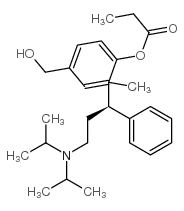Fesoterodine L-mandelate
Modify Date: 2025-09-10 18:17:02

Fesoterodine L-mandelate structure
|
Common Name | Fesoterodine L-mandelate | ||
|---|---|---|---|---|
| CAS Number | 1206695-46-6 | Molecular Weight | 563.72400 | |
| Density | N/A | Boiling Point | N/A | |
| Molecular Formula | C34H45NO6 | Melting Point | N/A | |
| MSDS | N/A | Flash Point | N/A | |
Use of Fesoterodine L-mandelateFesoterodine L-mandelate is an orally active, nonsubtype selective, competitive muscarinic receptor (mAChR) antagonist with pKi values of 8.0, 7.7, 7.4, 7.3, 7.5 for M1, M2, M3, M4, M5 receptors, respectively. Fesoterodine L-mandelate is used for the overactive bladder (OAB)[1][2]. |
| Name | 2-[(1R)-3-[bis(1-methylethyl)amino]-1-phenylpropyl]-4-hydroxy-methylphenyl isobutyrate mandelate |
|---|---|
| Synonym | More Synonyms |
| Description | Fesoterodine L-mandelate is an orally active, nonsubtype selective, competitive muscarinic receptor (mAChR) antagonist with pKi values of 8.0, 7.7, 7.4, 7.3, 7.5 for M1, M2, M3, M4, M5 receptors, respectively. Fesoterodine L-mandelate is used for the overactive bladder (OAB)[1][2]. |
|---|---|
| Related Catalog | |
| Target |
pKi: 8.0 (M1), 7.7 (M2), 7.4 (M3), 7.3 (M4) and 7.5 (M5)[3] |
| In Vitro | Fesoterodine L-mandelate decreases micturition frequency, urgency severity and urgency incontinence episodes and increases the volume voided with each micturition[1]. After oral administration, Fesoterodine L-mandelate is rapidly and extensively hydrolysed in plasma by nonspecific esterases to Desfesoterodine (5-hydroxymethyl tolterodine; SPM 7605; HY-76569; an active metabolite of Fesoterodine)[3][4]. |
| In Vivo | Fesoterodine L-mandelate (0.01-1 mg/kg; IV) reduces the micturition pressure and increases bladder capacity and ICIs (intercontraction intervas) at the lowest dose tested of 0.01 mg/kg[3]. Animal Model: Bladders from female Sprague-Dawley rats (225-275 g)[3] Dosage: 0.01, 0.1 and 1 mg/kg Administration: IV Result: Reduced the micturition pressure and increased bladder capacity and ICIs at the lowest dose tested of 0.01 mg/kg. |
| References |
| Molecular Formula | C34H45NO6 |
|---|---|
| Molecular Weight | 563.72400 |
| Exact Mass | 563.32500 |
| PSA | 107.30000 |
| LogP | 6.18570 |
| InChIKey | BUMCIEARGQDQNL-SXTNJFIWSA-N |
| SMILES | CC(C)C(=O)Oc1ccc(CO)cc1C(CCN(C(C)C)C(C)C)c1ccccc1.O=C(O)C(O)c1ccccc1 |
| Precursor 0 | |
|---|---|
| DownStream 1 | |
| fesoterodine mandelate |
 CAS#:286930-02-7
CAS#:286930-02-7